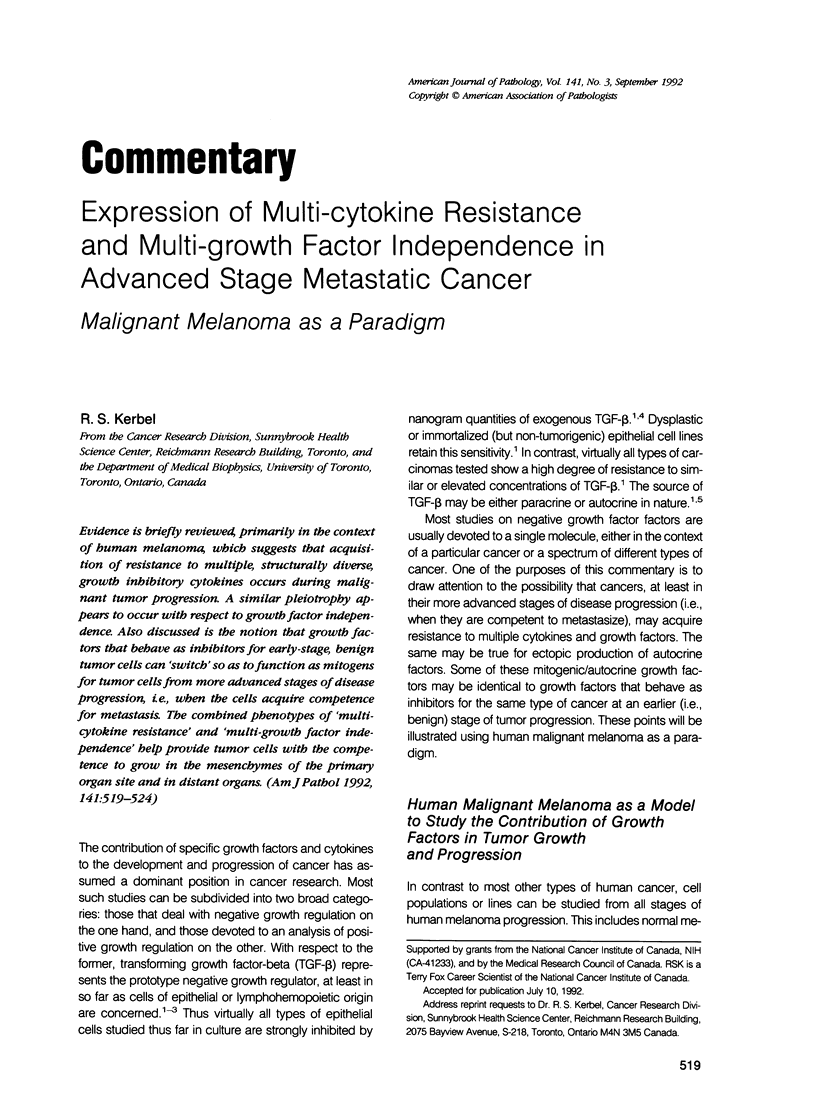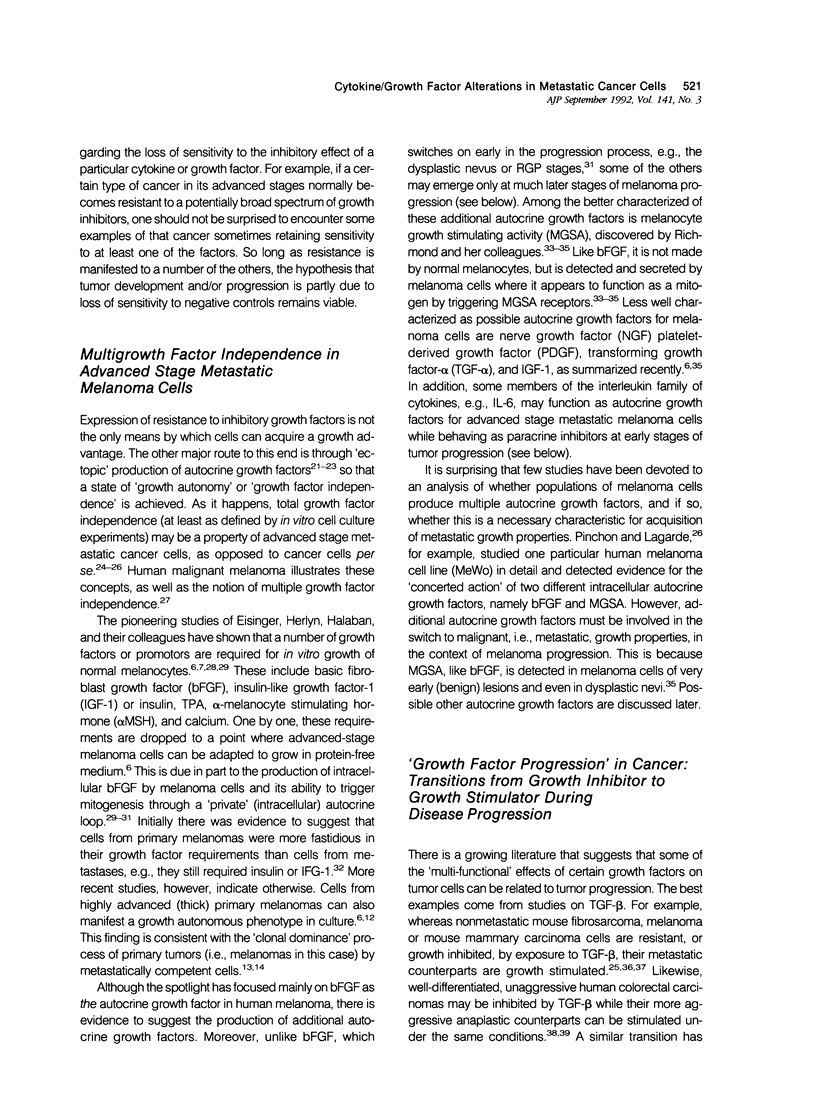Abstract
Evidence is briefly reviewed, primarily in the context of human melanoma, which suggests that acquisition of resistance to multiple, structurally diverse, growth inhibitory cytokines occurs during malignant tumor progression. A similar pleiotrophy appears to occur with respect to growth factor independence. Also discussed is the notion that growth factors that behave as inhibitors for early-stage, benign tumor cells can 'switch' so as to function as mitogens for tumor cells from more advanced stages of disease progression, i.e., when the cells acquire competence for metastasis. The combined phenotypes of 'multicytokine resistance' and 'multi-growth factor independence' help provide tumor cells with the competence to grow in the mesenchymes of the primary organ site and in distant organs.
Full text
PDF





Selected References
These references are in PubMed. This may not be the complete list of references from this article.
- Aaronson S. A. Growth factors and cancer. Science. 1991 Nov 22;254(5035):1146–1153. doi: 10.1126/science.1659742. [DOI] [PubMed] [Google Scholar]
- Balentien E., Mufson B. E., Shattuck R. L., Derynck R., Richmond A. Effects of MGSA/GRO alpha on melanocyte transformation. Oncogene. 1991 Jul;6(7):1115–1124. [PubMed] [Google Scholar]
- Barnard J. A., Lyons R. M., Moses H. L. The cell biology of transforming growth factor beta. Biochim Biophys Acta. 1990 Jun 1;1032(1):79–87. doi: 10.1016/0304-419x(90)90013-q. [DOI] [PubMed] [Google Scholar]
- Becker D., Meier C. B., Herlyn M. Proliferation of human malignant melanomas is inhibited by antisense oligodeoxynucleotides targeted against basic fibroblast growth factor. EMBO J. 1989 Dec 1;8(12):3685–3691. doi: 10.1002/j.1460-2075.1989.tb08543.x. [DOI] [PMC free article] [PubMed] [Google Scholar]
- Bordoni R., Fine R., Murray D., Richmond A. Characterization of the role of melanoma growth stimulatory activity (MGSA) in the growth of normal melanocytes, nevocytes, and malignant melanocytes. J Cell Biochem. 1990 Dec;44(4):207–219. doi: 10.1002/jcb.240440403. [DOI] [PubMed] [Google Scholar]
- Bradley G., Juranka P. F., Ling V. Mechanism of multidrug resistance. Biochim Biophys Acta. 1988 Aug 3;948(1):87–128. doi: 10.1016/0304-419x(88)90006-6. [DOI] [PubMed] [Google Scholar]
- Browder T. M., Dunbar C. E., Nienhuis A. W. Private and public autocrine loops in neoplastic cells. Cancer Cells. 1989 Sep;1(1):9–17. [PubMed] [Google Scholar]
- Chadwick D. E., Lagarde A. E. Coincidental acquisition of growth autonomy and metastatic potential during the malignant transformation of factor-dependent CCL39 lung fibroblasts. J Natl Cancer Inst. 1988 May 4;80(5):318–325. doi: 10.1093/jnci/80.5.318. [DOI] [PubMed] [Google Scholar]
- Clark W. H. Tumour progression and the nature of cancer. Br J Cancer. 1991 Oct;64(4):631–644. doi: 10.1038/bjc.1991.375. [DOI] [PMC free article] [PubMed] [Google Scholar]
- Cornil I., Theodorescu D., Man S., Herlyn M., Jambrosic J., Kerbel R. S. Fibroblast cell interactions with human melanoma cells affect tumor cell growth as a function of tumor progression. Proc Natl Acad Sci U S A. 1991 Jul 15;88(14):6028–6032. doi: 10.1073/pnas.88.14.6028. [DOI] [PMC free article] [PubMed] [Google Scholar]
- Eisinger M., Marko O., Ogata S., Old L. J. Growth regulation of human melanocytes: mitogenic factors in extracts of melanoma, astrocytoma, and fibroblast cell lines. Science. 1985 Sep 6;229(4717):984–986. doi: 10.1126/science.4023718. [DOI] [PubMed] [Google Scholar]
- Ethier S. P., Moorthy R. Multiple growth factor independence in rat mammary carcinoma cells. Breast Cancer Res Treat. 1991 May;18(2):73–81. doi: 10.1007/BF01980969. [DOI] [PubMed] [Google Scholar]
- Fearon E. R., Vogelstein B. A genetic model for colorectal tumorigenesis. Cell. 1990 Jun 1;61(5):759–767. doi: 10.1016/0092-8674(90)90186-i. [DOI] [PubMed] [Google Scholar]
- Halaban R., Kwon B. S., Ghosh S., Delli Bovi P., Baird A. bFGF as an autocrine growth factor for human melanomas. Oncogene Res. 1988 Sep;3(2):177–186. [PubMed] [Google Scholar]
- Herlyn M., Clark W. H., Rodeck U., Mancianti M. L., Jambrosic J., Koprowski H. Biology of tumor progression in human melanocytes. Lab Invest. 1987 May;56(5):461–474. [PubMed] [Google Scholar]
- Herlyn M. Human melanoma: development and progression. Cancer Metastasis Rev. 1990 Sep;9(2):101–112. doi: 10.1007/BF00046337. [DOI] [PubMed] [Google Scholar]
- Herlyn M., Kath R., Williams N., Valyi-Nagy I., Rodeck U. Growth-regulatory factors for normal, premalignant, and malignant human cells in vitro. Adv Cancer Res. 1990;54:213–234. doi: 10.1016/s0065-230x(08)60812-x. [DOI] [PubMed] [Google Scholar]
- Holzmann B., Bröcker E. B., Lehmann J. M., Ruiter D. J., Sorg C., Riethmüller G., Johnson J. P. Tumor progression in human malignant melanoma: five stages defined by their antigenic phenotypes. Int J Cancer. 1987 Apr 15;39(4):466–471. doi: 10.1002/ijc.2910390410. [DOI] [PubMed] [Google Scholar]
- Jennings M. T., Maciunas R. J., Carver R., Bascom C. C., Juneau P., Misulis K., Moses H. L. TGF beta 1 and TGF beta 2 are potential growth regulators for low-grade and malignant gliomas in vitro: evidence in support of an autocrine hypothesis. Int J Cancer. 1991 Aug 19;49(1):129–139. doi: 10.1002/ijc.2910490124. [DOI] [PubMed] [Google Scholar]
- Kerbel R. S., Waghorne C., Korczak B., Lagarde A., Breitman M. L. Clonal dominance of primary tumours by metastatic cells: genetic analysis and biological implications. Cancer Surv. 1988;7(4):597–629. [PubMed] [Google Scholar]
- Levy Y., Tsapis A., Brouet J. C. Interleukin-6 antisense oligonucleotides inhibit the growth of human myeloma cell lines. J Clin Invest. 1991 Aug;88(2):696–699. doi: 10.1172/JCI115355. [DOI] [PMC free article] [PubMed] [Google Scholar]
- Manning A. M., Williams A. C., Game S. M., Paraskeva C. Differential sensitivity of human colonic adenoma and carcinoma cells to transforming growth factor beta (TGF-beta): conversion of an adenoma cell line to a tumorigenic phenotype is accompanied by a reduced response to the inhibitory effects of TGF-beta. Oncogene. 1991 Aug;6(8):1471–1476. [PubMed] [Google Scholar]
- Miki S., Iwano M., Miki Y., Yamamoto M., Tang B., Yokokawa K., Sonoda T., Hirano T., Kishimoto T. Interleukin-6 (IL-6) functions as an in vitro autocrine growth factor in renal cell carcinomas. FEBS Lett. 1989 Jul 3;250(2):607–610. doi: 10.1016/0014-5793(89)80805-1. [DOI] [PubMed] [Google Scholar]
- Mooradian D. L., Purchio A. F., Furcht L. T. Differential effects of transforming growth factor beta 1 on the growth of poorly and highly metastatic murine melanoma cells. Cancer Res. 1990 Jan 15;50(2):273–277. [PubMed] [Google Scholar]
- Morikawa K., Morikawa R., Killion J. J., Fan D., Fidler I. J. Isolation of human colon carcinoma cells for resistance to a single interferon associated with cross-resistance to multiple recombinant interferons: alpha, beta, and gamma. J Natl Cancer Inst. 1990 Mar 21;82(6):517–522. doi: 10.1093/jnci/82.6.517. [DOI] [PubMed] [Google Scholar]
- Newman M. J. Inhibition of carcinoma and melanoma cell growth by type 1 transforming growth factor beta is dependent on the presence of polyunsaturated fatty acids. Proc Natl Acad Sci U S A. 1990 Jul;87(14):5543–5547. doi: 10.1073/pnas.87.14.5543. [DOI] [PMC free article] [PubMed] [Google Scholar]
- Pichon F., Lagarde A. E. Autoregulation of MeWo metastatic melanoma cell growth: characterization of intracellular (FGF, MGSA) and secreted (PDGF) growth factors. J Cell Physiol. 1989 Aug;140(2):344–358. doi: 10.1002/jcp.1041400221. [DOI] [PubMed] [Google Scholar]
- Richmond A. The pathogenic role of growth factors in melanoma. Semin Dermatol. 1991 Sep;10(3):246–255. [PubMed] [Google Scholar]
- Roberts A. B., Sporn M. B. Transforming growth factor beta. Adv Cancer Res. 1988;51:107–145. [PubMed] [Google Scholar]
- Rodeck U., Becker D., Herlyn M. Basic fibroblast growth factor in human melanoma. Cancer Cells. 1991 Aug;3(8):308–311. [PubMed] [Google Scholar]
- Rodeck U., Herlyn M., Menssen H. D., Furlanetto R. W., Koprowsk H. Metastatic but not primary melanoma cell lines grow in vitro independently of exogenous growth factors. Int J Cancer. 1987 Nov 15;40(5):687–690. doi: 10.1002/ijc.2910400520. [DOI] [PubMed] [Google Scholar]
- Schroy P., Rifkin J., Coffey R. J., Winawer S., Friedman E. Role of transforming growth factor beta 1 in induction of colon carcinoma differentiation by hexamethylene bisacetamide. Cancer Res. 1990 Jan 15;50(2):261–265. [PubMed] [Google Scholar]
- Schwarz L. C., Gingras M. C., Goldberg G., Greenberg A. H., Wright J. A. Loss of growth factor dependence and conversion of transforming growth factor-beta 1 inhibition to stimulation in metastatic H-ras-transformed murine fibroblasts. Cancer Res. 1988 Dec 15;48(24 Pt 1):6999–7003. [PubMed] [Google Scholar]
- Serve H., Steinhauser G., Oberberg D., Flegel W. A., Northoff H., Berdel W. E. Studies on the interaction between interleukin 6 and human malignant nonhematopoietic cell lines. Cancer Res. 1991 Aug 1;51(15):3862–3866. [PubMed] [Google Scholar]
- Siegall C. B., Schwab G., Nordan R. P., FitzGerald D. J., Pastan I. Expression of the interleukin 6 receptor and interleukin 6 in prostate carcinoma cells. Cancer Res. 1990 Dec 15;50(24):7786–7788. [PubMed] [Google Scholar]
- Sporn M. B., Roberts A. B. Autocrine growth factors and cancer. 1985 Feb 28-Mar 6Nature. 313(6005):745–747. doi: 10.1038/313745a0. [DOI] [PubMed] [Google Scholar]
- Sporn M. B., Roberts A. B. Peptide growth factors are multifunctional. Nature. 1988 Mar 17;332(6161):217–219. doi: 10.1038/332217a0. [DOI] [PubMed] [Google Scholar]
- Sporn M. B., Todaro G. J. Autocrine secretion and malignant transformation of cells. N Engl J Med. 1980 Oct 9;303(15):878–880. doi: 10.1056/NEJM198010093031511. [DOI] [PubMed] [Google Scholar]
- Tabibzadeh S. S., Poubouridis D., May L. T., Sehgal P. B. Interleukin-6 immunoreactivity in human tumors. Am J Pathol. 1989 Sep;135(3):427–433. [PMC free article] [PubMed] [Google Scholar]
- Takenawa J., Kaneko Y., Fukumoto M., Fukatsu A., Hirano T., Fukuyama H., Nakayama H., Fujita J., Yoshida O. Enhanced expression of interleukin-6 in primary human renal cell carcinomas. J Natl Cancer Inst. 1991 Nov 20;83(22):1668–1672. doi: 10.1093/jnci/83.22.1668. [DOI] [PubMed] [Google Scholar]
- Theodorescu D., Caltabiano M., Greig R., Rieman D., Kerbel R. S. Reduction of TGF-beta activity abrogates growth promoting tumor cell-cell interactions in vivo. J Cell Physiol. 1991 Sep;148(3):380–390. doi: 10.1002/jcp.1041480308. [DOI] [PubMed] [Google Scholar]
- Van Meir E., Sawamura Y., Diserens A. C., Hamou M. F., de Tribolet N. Human glioblastoma cells release interleukin 6 in vivo and in vitro. Cancer Res. 1990 Oct 15;50(20):6683–6688. [PubMed] [Google Scholar]
- Watson J. M., Sensintaffar J. L., Berek J. S., Martínez-Maza O. Constitutive production of interleukin 6 by ovarian cancer cell lines and by primary ovarian tumor cultures. Cancer Res. 1990 Nov 1;50(21):6959–6965. [PubMed] [Google Scholar]
- Yan Z., Hsu S., Winawer S., Friedman E. Transforming growth factor beta 1 (TGF-beta 1) inhibits retinoblastoma gene expression but not pRB phosphorylation in TGF-beta 1-growth stimulated colon carcinoma cells. Oncogene. 1992 Apr;7(4):801–805. [PubMed] [Google Scholar]


